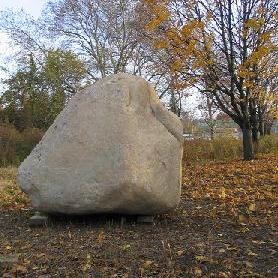Sometimes in the course of progress, a happy accident occurs. One such incident happened in late October in our sister borough.
On October 24th, a contractor excavating a street for a new sewer line in Fort Greene, Brooklyn unearthed an enormous boulder. Without ceremony, he set it down upon quiet, tree-lined Vanderbilt Avenue next to a curb. However, when word got out about its discovery, it quickly became the center of attention. For about a week, admirers came from far and wide to touch, gaze upon and snap photos of the spectacle. Neighbors invited friends over to gawk at its size. Even jaded New Yorkers realized that this was something special – it’s not every day that a 7-foot tall, 10-ton chunk of prehistory is discovered and displayed on an urban street.
Geologists have estimated the granite rock to be 400 million years old, probably originating from the shoreline of northwestern Queens. The gigantic rock likely was moved via glacier and deposited at Fort Greene during the last ice age. Large stones transported by glacial movement are known as “glacial erratics.” The particular type of granite present in this stone is “ravenswood granodiorite,” named after the Ravenswood section of Long Island City, where a stretch of exposed bedrock exhibits the same type of composition. The rock contains mica and quartz minerals and will sparkle in the sun once it undergoes a good cleaning. Parts of it are reported to have magnetic properties as well.
The equipment operator who extracted the rock did not seem impressed by it. On October 28th, the NY Times quoted him as saying, “It was just in my way. Next week, we’ll take it to the dump.” However, upon hearing of the Brooklyn discovery, Queens Parks Commissioner Dottie Lewandowski promptly took action, and on November 2nd, a flatbed truck transported the boulder to the former Keyspan site in Elmhurst. It now sits in full view just inside the fence along Grand Avenue, awaiting incorporation into the design of our much-anticipated future park. Ms. Lewandowski told the NY Times, “The community really wants a naturalistic setting, and a rock of this size and scale is just perfect for what we’re trying to do. We are very excited about this rock.”
Over the next few days, three more boulders of similar type but smaller size were also uncovered. The two smallest ones were sent to Pugsley Creek Park in the Bronx, while a larger one will be placed in Fort Greene Park, remaining in the neighborhood where it was found. Some residents expressed disappointment at losing the largest of their rocks to Queens, but they should take comfort in the fact that it is being returned to its borough of origin and will be much appreciated in its new setting.
Parks Press Officer Abbie Lootens has provided an update on the progress of park construction. Ground will be broken in Spring 2007 for the first phase of development. This will include providing fill for landscaping, installation of sidewalks, retaining walls, fences and gates and the planting of trees. The first phase is expected to take a year to complete and the park will open to the public sometime in Spring 2008. The community will then be asked for further input about phase two, which may include the addition of a small playground, walking paths, a comfort station, a flagpole, a kinetic sculpture, benches, a quiet sitting area for seniors, possibly a small area of synthetic turf for 'pick-up' ball play, additional plantings and an underground irrigation system. As of now, the site is expected to be named “Gas Tank Park,” although that may change depending on the wishes of the community.



